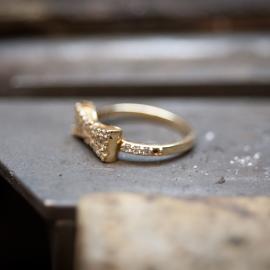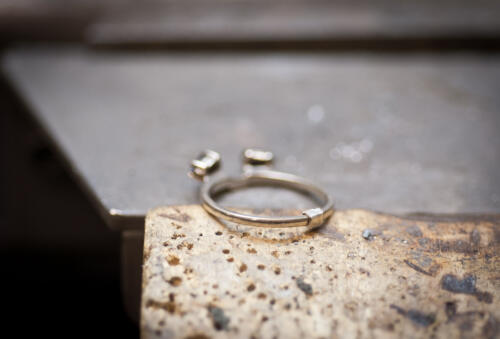3 Things You Might Not Know About Jewelry Repair
Learn from Sacramento's jewelry repair experts
Jewelry repair can be a confusing thing, especially if you don’t know much about how it’s done. At Arden Jewelers, our expert bench jewelers have been doing jewelry repair in Sacramento for decades. We’re here to answer any questions you have and provide you with professional service that you won’t find anywhere else.
1. Even high quality jewelry needs maintenance
Fine jewelry is made from some very durable materials: metals and gemstones. We think of metals as very strong. Metal is what skyscrapers and bridges are made out of. We can’t bend or even scratch most metals without the help of tools. Gemstones are rocks which we think of as hard and unbreakable. Diamonds are used in industrial tools to cut through even the toughest materials. So, why would something made from such strong substances need regular maintenance?
The answer is twofold. First, the metals and gemstones in jewelry are not always as impervious as we imagine. Gold, platinum, and silver are very soft as metals go. In fact, a large part of what makes them perfect for jewelry is how soft and workable they are. The result of this, however, is that the daily wear and tear we put on our jewelry takes more of a toll than we think. Also, not all gemstones are as hard as diamonds. Gems like opal, emerald, pearls, and more are actually very “soft” on the hardness scale. This means that they are susceptible to small scratches and abrasions which make them look worn over time. Of course, no gemstone is unbreakable, and even diamonds can be broken if they are hit at the wrong angle.
The second reason jewelry needs regular maintenance is that we are often a lot harder on our jewelry than we realize. Even a relatively light impact at the wrong place can knock a small gem out of its setting. Activities like gardening and washing dishes are particular hard on jewelry. The simple sliding of a pendant along its chain can eventually wear completely through the bail. Even something as simple as hand lotion can build up in the small crevasses in rings causing the gems to lose some of their sparkle.
Does your jewelry need some TLC? We offer a free jewelry evaluation service. We’ll have our expert gemologists and bench jewelers examine your jewelry to see if any maintenance is needed.
2. We add gold when we size rings up
A client recently expressed concern that her ring would be too thin after we sized it up. She thought, as many do, that when we size a ring, we just stretch it up, causing it to get thinner. In fact, sizing a ring up is a bit more complicated than that. The jeweler actually cuts the ring, and opens it up the right amount to achieve the new size. Then, a new piece of metal is prepared to match the ring in color and shape. Finally, the jewelry will weld or solder that piece into the ring and smooth it down to match the rings shank profile.
Now, there is one case where we will stretch a ring if we can. With wedding bands, it is often better to maintain the structural integrity of the band by stretching it, instead of cutting and sizing. However, if the band is not one solid piece (it has been cut before) or if stretching will make it too thing, we will still opt to add metal like normal.
3. Some gems can’t take the heat
Diamonds can take a lot. Forged under high pressure and temperature, a diamond can take a tremendous amount of heat before it is damaged. This isn’t the case with all gemstones, however. More fragile gems like opal, pearls, amethyst, topaz, and many others are easily damaged if exposed to excess heat. What does this have to do with jewelry repair?
Many repairs are traditionally done with a torch. Jobs like soldering broken chains, retipping worn prongs, and sizing a ring all require a great deal of heat. However, if a fragile gemstone is set in jewelry that needs this work, there can be a problem. One solution is to go through the time consuming and expensive process of removing each gemstone from the piece before the work is done and resetting them after it is finished. Our solution is to use a high-tech laser welder to only apply heat at the tiniest pin-point where we need it. This way, your fragile gems stay nice and cool, and we can do the required work in much less time and for much less money.
We hope you enjoyed this little run down on jewelry repair. Have questions? Leave us a comment below. We would love to talk with you. Or, if you’re in the Sacramento, CA area, feel free to bring your jewelry in and our jewelry repair experts can take a look at it for you.


Hi thanks for the great write up on jewelry repair. Helped clarify many questions I had regarding a repair I am interested in doing. Rather a modification, than repair. I have a 12mm 14K/SS/Turquoise Alwand Vahan bangle bracelet that I am interested in modifying – reducing the bracelet diameter. It was made for a 8.75 -9.5 wrist versa 7.0-7.5 standard bracelet size. The turquoise I suspect is a soft gem not able to take the heat but they can be easily removed in order to cut the excess SS bangle. Question is if it is possible to laser/cut off the end 14K/SS cuffs, reduce the SS bracelet equally on each side to maintain shape and then weld the cuffs back on?
Hi Mary, you are welcome. It’s great to hear the article was helpful. You are right about Turquoise not being able to take heat, but I would be more concerned about the prospect of bending the bracelet into shape after we shorten it. Without seeing it, we can’t say for sure (feel free to email us pictures at service@mygemologist.com), but if it’s hollow, it might not be possible to bend. Hopefully that helps, and if you’re local, our jewelers would be happy to look at your piece and advise you on the best course of action.